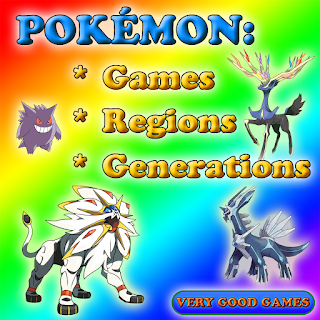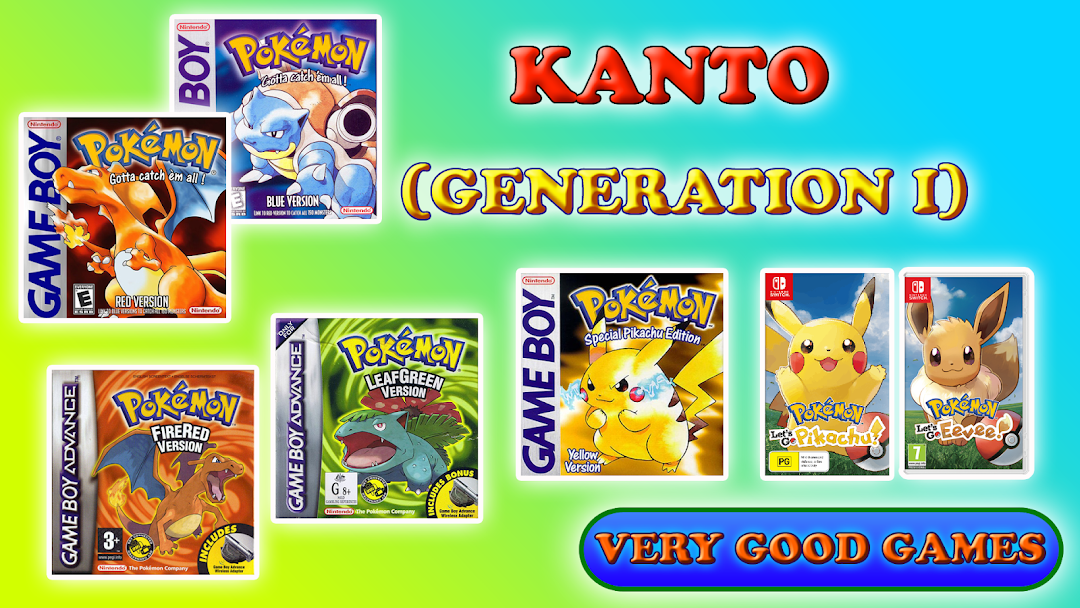There are lots of games in the vast universe of Pokémon. The series of the original games, classic Pokémon adventures, starts with the Pokémon Red and Blue (for GameBoy devices) and continues with some totally new instalments and some well-elaborated remastered versions. And there are satellites of the main “hits”, additional adventures for Pokémon trainers to keep their interest to the series and to give them more entertainments with favourite creatures. For example, such games are: Pokémon Ranger, Pokkén Tournament, Pokémon Quest, Pokémon Duel, Pokémon Shuffle, etc.
A big number of games can confuse players. The developers don’t make the situation easier, producing two almost identical titles for every game and messing up the timeline of the series by releasing old instalments for new devices with seemingly no particular order.
To understand the whole series, and to make everything clear for myself and for other gamers, interested in the Pokémon world, I’ve created this post with all the Pokémon games grouped by regions and creatures generations. So, let’s start!
Kanto region – Generation I
- Pokémon Red and Blue – original entries (GameBoy, Nintendo 2/3DS);
- Pokémon Yellow – a combined and improved version of Red/Blue (GameBoy, Nintendo 2/3DS);
- Pokémon FireRed and LeafGreen – remastered versions of Red/Blue (GameBoy Advance);
- Let’s Go Eevee and Let’s Go Pikachu – remastered versions of Yellow (Nintendo Switch).
It’s the start of the epic adventures. Kanto region is made on the base of the Kantō region in Japan. Players can collect here the very first 151 creatures (have a look at them in my post All Pokémon of Generation I).
Johto region – Generation II
- Pokémon Gold and Silver – original games (GameBoy Color, Nintendo 2/3DS);
- Pokémon Crystal – a combined and improved version of Gold/Silver (GameBoy Color);
- Pokémon HeartGold and SoulSilver – remastered versions of Gold/Silver (Nintendo DS).
The Pokémon story continues with new heroes. Johto is again based on Japan, but this time on the areas Kansai, Tokai, and eastern Shikoku. 100 Pokémon of Gen II have been added to the Pokédex, so the total number of creatures became 251.
Check out the post All Pokémon of Generation II.
Hoenn – Generation III
- Pokémon Ruby and Sapphire – original games (GameBoy Advance);
- Pokémon Emerald - a combined and improved version of Ruby/Sapphire (GameBoy Color);
- Pokémon Omega Ruby and Alpha Sapphire – remastered versions of Ruby/Sapphire (Nintendo 2/3DS).
This time, game events take place in a virtual copy of the Japanese island Kyushu and some small islands around. Trainers can collect 202 Pokémon here. The Generation III contains 135 creatures.
Check out the post All the Pokémon of Generation III.
Sinnoh – Generation IV
- Pokémon Diamond and Pearl – original games (Nintendo DS);
- Pokémon Platinum – a combined and improved version of Diamond/Perl (Nintendo DS).
Adventures move to a virtual version of Hokkaido, the north Japanese island. Players can collect 151 Pokémon in Diamond/Perl and 210 in Platinum. The Generation VI contains 107 creatures.
Unova – Generation V
- Pokémon Black and White – original games (Nintendo DS);
- Pokémon Black 2 and White 2 – sequels to Black/White (Nintendo DS).
For the first time in the Pokémon series, the developers made a non-Japanese virtual location. The world of these games is based on Manhattan Island. Players can collect 156 creatures to the Pokédex of Black/White and 300 of Black 2/White 2. Then, there is the possibility to get National Dex and collect all the other creatures of all generations (up to the fifth one).
Generation V contains 156 Pokémon.
Kalos – Generation VI
- Pokémon X and Y – original games (Nintendo 2/3DS).
Players delve into virtual France and can collect 457 Pokémon.
Generation VI contains 72 creatures.
Alola – Generation VII
- Pokémon Sun and Moon – original games (Nintendo 2/3DS);
- Pokémon Ultra Sun and Ultra Moon – improved versions of Sun/Moon (Nintendo 2/3DS).
Pokémon trainers travel across virtual Hawaii. The total number of creatures is 302 for Sun/Moon and 403 for Ultra Sun/Ultra Moon.
Generation VII contains 86 Pokémon.
Generation VIII
- Pokémon Swoed and Shield – core role-playing games for the Nintendo Switch consoles.
Events of these games take place in the Galar region, similar to Great Britain.
Two Pokémon of Generation VIII were presented in games Pokémon Go and Pokémon Let’s Go Eevee and Pikachu: Meltan and Melmetal. Three starter Pokémon appeared in the first reveal trailer: Grookey (grass), Scorbunny (fire), and Sobble (water). Many others became known in multiple videos before the games release, including specific Galar forms of old creatures. The total number of Pokémon in Galar is 400 (with no National Pokédex). 81 of them are new in the game series.
Two Pokémon of Generation VIII were presented in games Pokémon Go and Pokémon Let’s Go Eevee and Pikachu: Meltan and Melmetal. Three starter Pokémon appeared in the first reveal trailer: Grookey (grass), Scorbunny (fire), and Sobble (water). Many others became known in multiple videos before the games release, including specific Galar forms of old creatures. The total number of Pokémon in Galar is 400 (with no National Pokédex). 81 of them are new in the game series.
The total number of Pokémon is 890 (as for November 2019).
Why there are two versions of Pokémon games?
This is quite an interesting decision of the developers – they release two versions of the same Pokémon game, making them slightly different from each other (Red/Blue; Gold/Silver; Sun/Moon). This is very good for some enthusiastic trainers, who can experience one adventure twice and get new shades of it in the second attempt (new creatures and some new aspects of the plot). Of course, the primary benefit here is of marketing: the company can sell more games to collectors.
For the most gamers, it’s totally enough to have only one version of each game.
See also…
The genre of the original Pokémon games is RPG. If you like it, check out the collection of free online Role-Playing Games on this blog:
The most sensational game with these creatures is Pokémon Go. Here is a review of it:















